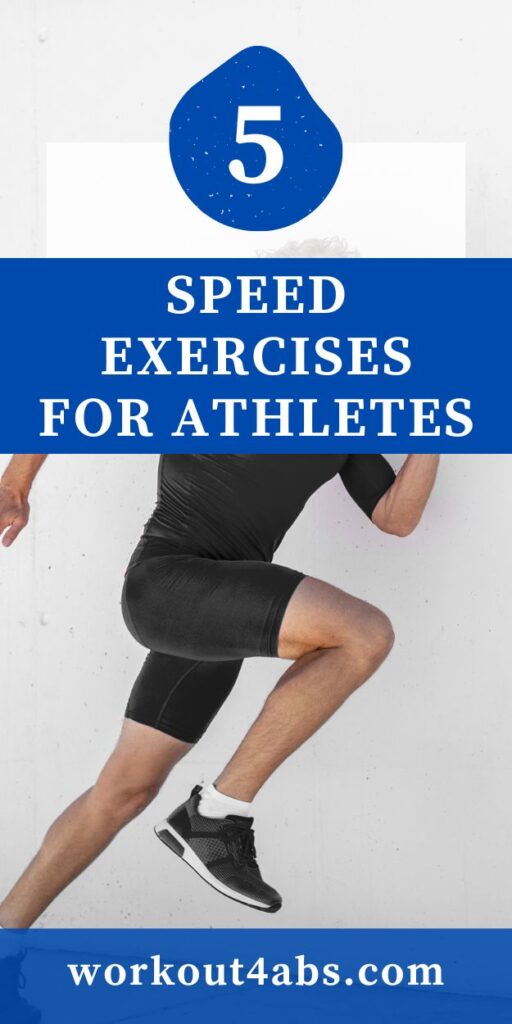Discover speed training drills that enhance speed and agility in sports. Mastering these three critical elements becomes paramount: the explosive start, the crucial acceleration phase, and the finesse of maximal mechanics. In this article, we’ll explore five dynamic bodyweight exercises designed to fine-tune these elements and elevate your athletic performance to new heights.
Top 5 Bodyweight SPEED Exercises For Athletes | AT HOME WORKOUT
A Rapid Start
Having a rapid start is crucial for increasing speed in sports because it sets the foundation for an athlete’s overall performance. A quick and explosive start provides several advantages that directly contribute to enhanced speed and agility:
- Acceleration: A rapid start allows athletes to accelerate quickly from a standstill or a low-speed position. The ability to go from a stationary or slow-moving state to top speed in a short amount of time is essential in many sports, such as sprinting, football, basketball, and tennis.
- Momentum: A fast start helps athletes build momentum early in a race or game, giving them a competitive edge. Momentum enables athletes to maintain higher speeds and cover more ground in less time, making it easier to outpace opponents.
- Psychological Advantage: A quick start can also provide a psychological advantage by boosting an athlete’s confidence and intimidating opponents. When an athlete bursts off the line or starts a race with explosive speed, it can demoralize competitors and create a perception of dominance.
- Positioning: In team sports like soccer or basketball, a rapid start can help an athlete gain favorable positioning over their opponents. This can be particularly crucial for securing scoring opportunities or defending against an opponent’s attack.
- Reaction Time: A fast start often requires quick reaction times, as athletes need to respond to a starting signal or an opponent’s movements. Improving reaction time is a fundamental aspect of enhancing speed in sports.
To achieve a rapid start and improve overall speed, athletes can focus on various aspects of their training:
- Strength and Power: Building lower-body strength and explosive power is essential for generating the force needed to propel oneself forward rapidly. Exercises like squats, deadlifts, and plyometrics can help in this regard.
- Technique: Proper technique is vital for optimizing the start in sports like sprinting, where a false step or inefficient movement can cost valuable milliseconds. Coaches can help athletes refine their technique and ensure they use their energy efficiently.
- Agility Training: Agility drills and exercises can improve an athlete’s ability to change direction quickly, a skill that complements a rapid start. This is crucial in sports that involve frequent changes of direction, like soccer or basketball.
- Reaction Time Training: Athletes can work on their reaction time through drills and exercises that simulate game or race scenarios. This helps them respond faster to starting signals or opponent movements.
- Mental Preparation: Mental preparation and visualization techniques can help athletes develop a sharp focus and mental readiness to explode off the line. Visualizing a successful start can improve confidence and execution.
- Sprint Mechanics: Athletes should focus on sprint mechanics, including arm and leg movement, posture, and stride length, to maximize their speed potential from the start.
In conclusion, a rapid start is a fundamental component of achieving top speed in sports. By emphasizing strength, power, technique, agility, reaction time, and mental preparation, athletes can improve their ability to start quickly and gain a competitive advantage in their respective sports.
If you enjoyed these tips, please save this pin to your Pinterest Board.

5 Bodyweight Exercises to Increase Your Speed
1: A Skips
The “A-Skip” drill is a dynamic exercise commonly used in track and field and other sports to improve speed, particularly during the acceleration phase. It focuses on developing proper running mechanics and driving force into the ground. Here’s how to perform the “A-Skip” drill:
Step 1: Warm-Up Start with a proper warm-up to prepare your muscles and joints for the exercise. Perform light jogging, dynamic stretches, and mobility exercises to ensure you’re ready for the drills.
Step 2: Set Up Find a flat and clear area where you can perform the drill. You may use cones or markers to create a straight line or designated path if needed.
Step 3: Basic Positioning Stand upright with your feet hip-width apart and your arms relaxed at your sides.
Step 4: Start the Drill Follow these steps for each leg:
a) Drive Your Knee Up: Begin with one leg (let’s say your right leg). Lift your right knee up as high as comfortably possible while keeping your toes dorsiflexed (pointed up).
b) Extend Your Leg Forward: After driving your knee up, extend your right leg forward, focusing on pushing your foot into the ground with power. Imagine kicking through a door with your foot.
c) Snap Your Leg Down: As your extended leg reaches its maximum forward position, quickly snap it down and back underneath your hip. Your foot should land directly beneath your hip.
d) Cycle to the Next Step: Immediately repeat the same sequence with your left leg, creating a fluid, cycling motion.
Step 5: Maintain Good Posture Throughout the drill, maintain proper running posture: keep your back straight, chest up, and shoulders relaxed. Avoid leaning forward or backward.
Step 6: Stride Frequency Focus on achieving a rapid stride frequency while maintaining good form. The goal is to increase the number of cycles (steps) you can perform in a set time frame.
Step 7: Repetitions and Sets Start with shorter distances and gradually increase the length of your A-Step drills as you become more comfortable. Perform multiple repetitions for each leg during each set, and aim for several sets during your training session.
Step 8: Cool Down After completing your A-Step drills, engage in a proper cool-down routine, including static stretching to improve flexibility and reduce the risk of muscle soreness.
The “A-Step” drill is an effective way to develop strength, speed, and proper running mechanics, particularly during the acceleration phase. Regular practice can lead to improved stride length, stride frequency, and overall speed in various sports, including track and field, football, soccer, and basketball.
2: Dorsiflexion and Foot Strike
The dorsiflexion and foot strike drill is a useful exercise for improving running mechanics and promoting proper foot placement during sprinting and acceleration. Here’s how to perform this drill:
Step 1: Warm-Up Begin with a proper warm-up routine, including light jogging, dynamic stretches, and mobility exercises to prepare your muscles and joints for the drill.
Step 2: Set Up Find a flat and clear area where you can perform the drill, preferably a straight path or track. You may use markers or cones to designate specific points if needed.
Step 3: Basic Positioning Start in a standing position with your feet hip-width apart and your arms relaxed at your sides. Maintain good posture throughout the exercise.
Step 4: Dorsiflexion Follow these steps for each leg:
a) Lift Your Knee: Begin with one leg (let’s say your right leg). Lift your right knee up towards your chest, focusing on bringing it as high as comfortably possible while keeping your toes dorsiflexed (pointed up toward your shin).
b) Extend Your Leg Forward: After driving your knee up, extend your right leg forward, concentrating on driving your foot downward toward the ground with power.
c) Ground the Foot Underneath the Torso: As your foot makes contact with the ground, aim to land it directly underneath your hip or torso. This is crucial for maintaining efficient running mechanics and preventing overstriding, which can slow you down and increase the risk of injury.
d) Cycle to the Next Step: After grounding your right foot, immediately repeat the same sequence with your left leg, creating a fluid, cycling motion.
Step 5: Stride Frequency Focus on achieving a rapid stride frequency while emphasizing proper dorsiflexion and foot placement. The goal is to increase the number of cycles (steps) you can perform in a set time frame.
Step 6: Repetitions and Sets Start with shorter distances and gradually increase the length of your Dorsiflexion and Foot Strike drills as you become more comfortable. Perform multiple repetitions for each leg during each set, and aim for several sets during your training session.
Step 7: Cool Down After completing your drills, engage in a proper cool-down routine, including static stretching to improve flexibility and reduce the risk of muscle soreness.
This drill is designed to enhance your running mechanics by reinforcing proper dorsiflexion (toes up) and emphasizing the importance of a foot strike that occurs directly underneath your body’s center of mass. Over time, this can lead to improved speed, efficiency, and reduced injury risk during running and sprinting activities.
3: Single Leg Bounds
The single-leg bound exercise is a plyometric drill designed to improve speed, explosive power, and running mechanics. This exercise helps athletes enhance their ability to generate force and stride length while running. Here’s how to perform the single-leg bound exercise:
Step 1: Warm-Up Begin with a proper warm-up to prepare your muscles and joints for the exercise. Perform light jogging, dynamic stretches, and mobility exercises to ensure you’re ready for the drill.
Step 2: Set Up Find a flat and clear area where you can perform the exercise safely. You may use markers or cones to designate a straight path if needed.
Step 3: Basic Positioning Start by standing upright with good posture. Choose one leg to begin with; let’s start with the right leg.
Step 4: Execute the Bound Follow these steps for each leg:
a) Initial Push-Off: Begin by slightly bending your right knee and flexing your right hip. Simultaneously, swing your left arm forward and your right arm back for balance and momentum.
b) Explosive Leap: Push off forcefully with your right foot, extending your hip, knee, and ankle. Your goal is to leap forward as far as possible.
c) Maintain Good Form: As you’re in the air, focus on keeping your chest up, your core engaged, and your back straight. Your right knee should remain flexed during the flight phase.
d) Land on the Same Leg: Land on your right foot, with your toes pointing forward, and absorb the impact by slightly bending your right knee. Try to land softly and smoothly.
e) Repeat the Bound: After landing on your right foot, immediately transition into the next bound by explosively pushing off again with your right foot. This creates a bounding or hopping motion.
Step 5: Stride Frequency and Distance Focus on achieving a combination of stride frequency and distance with each bound. You want to cover as much ground as possible while maintaining good form and explosiveness.
Step 6: Repetitions and Sets Start with a shorter distance and gradually increase the length of your single-leg bounds as you become more comfortable. Perform multiple repetitions on each leg during each set, and aim for several sets during your training session.
Step 7: Cool Down After completing your single-leg bound drills, engage in a proper cool-down routine, including static stretching to improve flexibility and reduce the risk of muscle soreness.
The single-leg bound exercise is an excellent way to enhance your speed, power, and running mechanics. It helps you develop the ability to generate force and cover more ground with each stride, ultimately leading to improved sprinting and overall speed in sports.
If you enjoyed these tips, please save this pin to your Pinterest Board.

4: Tuck Jumps
Tuck jumps are a plyometric exercise that can help increase speed and explosiveness. They work on developing lower body power and strength, which are essential for generating speed and enhancing overall athletic performance. Here’s how to perform tuck jumps:
Step 1: Warm-Up Begin with a proper warm-up to prepare your muscles and joints for the exercise. Perform light jogging, dynamic stretches, and mobility exercises to ensure you’re ready for the workout.
Step 2: Set Up Find a flat and clear area where you can perform the tuck jumps safely, preferably on a soft surface like a gym mat or grass to minimize the impact on your joints.
Step 3: Basic Positioning Start by standing upright with your feet hip-width apart. Keep your arms relaxed at your sides.
Step 4: Execute the Tuck Jump Follow these steps to perform a tuck jump:
a) Initiate the Jump: Begin by bending your knees and hips to initiate a squat-like motion. Swing your arms forward and downward for momentum.
b) Explosive Leap: From the squat position, explode upward using your leg muscles. Simultaneously, tuck your knees toward your chest as you ascend, bringing them as close to your chest as possible.
c) Tuck Position: In mid-air, your thighs should be parallel to the ground, and your knees should be tucked close to your chest.
d) Extend Legs: Quickly extend your legs downward and prepare to land.
e) Land Softly: As you descend, aim to land softly on the balls of your feet with your knees slightly bent to absorb the impact. Keep your back straight and your core engaged to maintain balance.
Step 5: Strive for Height and Speed Focus on achieving maximum height and speed in your tuck jumps while maintaining good form. The goal is to explode off the ground as quickly and powerfully as possible.
Step 6: Repetitions and Sets Start with a manageable number of repetitions (e.g., 5-10) and gradually increase as you progress. Perform multiple sets of tuck jumps with adequate rest between sets.
Step 7: Cool Down After completing your tuck jumps, engage in a proper cool-down routine, including static stretching to improve flexibility and reduce the risk of muscle soreness.
Tuck jumps are effective for increasing lower body explosiveness and power, which can directly translate to improved speed and agility in sports. Incorporate them into your training routine along with other speed-enhancing exercises for a well-rounded approach to boosting your athletic performance.
5: Hill Sprints
Hill sprints are an effective and challenging exercise to increase speed, power, and endurance. They help build strength in the lower body, improve running mechanics, and boost cardiovascular fitness. Here’s how to do hill sprints:
Step 1: Find a Suitable Hill Select a hill with a moderate incline that is safe and free from obstacles. The length of the hill should be about 30 to 50 meters (100 to 165 feet) or shorter for beginners, gradually progressing to longer distances as you become more advanced.
Step 2: Warm-Up Begin with a thorough warm-up to prepare your muscles and joints for the intense workout ahead. Perform light jogging, dynamic stretches, and mobility exercises for about 10-15 minutes.
Step 3: Proper Footwear Wear appropriate running shoes with good traction for the hill. Make sure your shoes are in good condition to prevent slipping during the sprints.
Step 4: Sprint Technique Focus on proper sprinting technique:
- Start with your feet hip-width apart.
- Keep your chest up and shoulders relaxed.
- Drive your arms powerfully with each stride.
- Lift your knees and maintain a quick and powerful stride turnover.
- Aim to land on the balls of your feet with each step.
Step 5: The Sprint
Begin your hill sprint from a standing start or a slow jog at the base of the hill. Follow these steps:
a) Explosive Start: Explode off the line with maximum effort. Drive your arms forward and upward while lifting your knees high.
b) Maintain Form: As you ascend the hill, continue driving your knees and pumping your arms to maintain good form and maximize power.
c) Stride Length: Focus on taking powerful, controlled strides up the hill. Keep your stride length shorter than during flat sprints due to the hill’s incline.
d) Full Effort: Give your all during the sprint. Aim to reach near-maximum speed by the time you reach the top of the hill.
Step 6: Recovery Walk or jog slowly back down the hill to recover between sprints. The downhill walk serves as active recovery, allowing your heart rate to decrease while maintaining circulation.
Step 7: Repetitions and Sets Start with a manageable number of hill sprints (e.g., 4-6) and gradually increase as you become more conditioned. Aim for multiple sets, with ample rest (2-3 minutes) between each sprint and 2-3 minutes between sets.
Step 8: Cool Down After completing your hill sprints, engage in a proper cool-down routine, including static stretching to improve flexibility and reduce the risk of muscle soreness.
Hill sprints are an excellent way to increase speed, leg strength, and cardiovascular fitness. Incorporate them into your training regimen once or twice a week, and gradually progress by increasing the number of sprints, lengthening the hill distance, or choosing steeper inclines as your fitness improves.
If you enjoyed these tips, please save this pin to your Pinterest Board.

Home › Workout for Athletes ›Speed Training Drills